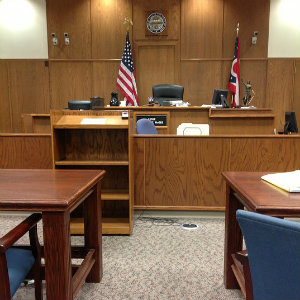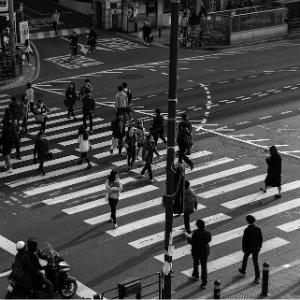Have you or a family member been injured as a pedestrian? You may have several questions:
- I was hit by a car. Will the driver's insurance cover my medical bills?
- What about lost wages from missing time at work?
- Who's responsible for my slip and fall on an icy sidewalk?
Whether you were injured by a negligent driver or by unsafe walking conditions, our experienced personal injury lawyers are here to help.

I'll take on the negligent driver or property owner who caused your injuries and secure the compensation you need during this difficult time.
Many people may not realize the variety of dangers pedestrians face while walking from point A to point B. In high traffic urban areas, pedestrians are some of the most vulnerable citizens when a reckless driver is in the area. And every day, pedestrians are injured due to property owner negligence on improperly maintained walking paths, sidewalks, and parking lots.
If you or a family member has suffered serious injuries or you've lost a family member as a result of motorist or property owner negligence, you have rights. We understand that you're burdened with a variety of physical and emotional burdens right now. While financial compensation cannot erase the past, it can help to make your recovery go more smoothly.
Do I Have A Case?
Whether you've been injured in a car accident or a slip and fall, both cases require you to prove negligence in order to seek compensation. Legally defined, negligence occurs when a party fails to act (or not act) in a way which protects others from preventable dangers. Under Pennsylvania law, you must prove four things for negligence:
- The driver or property owner owed you a legal duty of care
- He or she failed to meet this duty of care through a negligent act or omission
- This failure resulted in your accident and/or injuries
- You suffered as a result of this injury
FREE CONSULTATION
About Comparative Negligence
Additionally, these cases also involve a legal statute called comparative negligence. During a trial, the court will determine if your own negligence contributed to the accident and assign a corresponding percentage.
As long as you are determined to be less than 50% negligent, you'll be permitted to seek compensation. Your final compensation amount will be adjusted based on this percentage. For example, if you received a $50,000 verdict and were determined to be 10% responsible, your total payout would be reduced to $45,000.
Common examples of pedestrian negligence include:
- Crossing an intersection while ignoring a "stop" signal
- Walking into traffic and disrupting flow
- Jay-walking (failure to cross at marked intersection)
- Failure to avoid an obvious sidewalk obstruction
- Walking while looking down at a cell phone or other distraction
These cases are complex and involve many variables. It's best to consult with an attorney to determine the plausibility of a lawsuit.
Common Causes Of Pedestrian-Vehicle Accidents
You may be aware of how common car accidents are, but drivers aren't the only ones at risk. According to a study by the National Highway Traffic Safety Administration, in 2014 a pedestrian died every 2 hours and was injured every 8 minutes in auto accidents. No one should ever be forced to endure serious injuries or suddenly lose a family member because of an irresponsible motorist.
While some car accidents are the unavoidable result of specific circumstances (such as a snow squall killing visibility), pedestrian accidents can almost always be avoided by safer driving. Common contributing factors in pedestrian injuries and fatalities include:
- Drunk driving - Drunk drivers have impaired reaction times, which may prevent them from noticing a pedestrian or from stopping in time to avoid hitting one. The same NHTSA study found that alcohol was a factor in 49% of pedestrian-vehicle fatalities.
- Distracted driving - Any action which takes a driver's eyes off the road is a distraction. All it takes is a 3-second glance at a cell phone to make a fatal driving mistake, such as failure to stop at an intersection. Distracted drivers are much more likely to cause accidents both with other vehicles and pedestrians.
- Drowsy driving - Recent studies have claimed that drowsy driving is comparable to drunk driving. According to a 2005 poll by the National Sleep Foundation, 60% of adult drivers in the US admit to driving while drowsy in the past. Even scarier - 37% admit to falling asleep at the wheel. Drowsy drivers frequently drift out of their lanes - into adjacent lanes, oncoming traffic, or onto sidewalks and walking paths in urban areas.
- Speeding - Responsible motorists stay wary of pedestrians and make sure to slow down in high foot-traffic areas. Reckless drivers who speed through residential areas and city streets endanger pedestrians even more than fellow motorists. Generally, higher speeds during impact result in more serious injuries.
- Disobeying traffic laws - Pedestrians expect motorists to ensure their safety by obeying traffic laws. Failure to yield at crosswalks, ignoring traffic signs or signals, and failure to signal before turns all increase the risk of a pedestrian accident.
If you suspect that one or more of these negligent behaviors contributed to you or your family member's injuries, we strongly suggest contacting an experienced personal injury lawyer. You deserve to be compensated for the variety of struggles you're facing as a result of such recklessness.
Common Causes Of Slip, Trip, And Fall Accidents
Property owners (both homeowners and business owners) have a duty of care to maintain their properties and remove any hazardous conditions or at least warn visitors of them. This includes the sidewalks, parking lots, and walking paths outside of the property. Many pedestrians suffer serious injuries because of property owners who fail to meet this duty. Common pedestrian slip, trip, and fall accident causes include:
Ice and snow
Ice and snow must be cleared from walking surfaces within a reasonable amount of time. When determining negligence, PA law abides by the "Hills and Ridges" doctrine for winter weather conditions, which follows three rules:
- Ice and snow has accumulated in ridges or hills of a size which obstructs travel and presents a danger to pedestrians.
- The property owner was aware of the condition, or enough time had passed that he or she should have been aware.
- The accumulation of ice and snow caused the slip or fall
This doctrine is meant to protect property owners from unfair lawsuits, such as a slip or fall in the middle of a blizzard. Determining these criteria on your own may be exceedingly difficult. It's best to consult with an experienced slip and fall lawyer who has tried similar cases in the past.
Inadequate lighting
Inadequate lighting creates a variety of dangers for pedestrians. Obstructions, uneven elevations, and slick walking conditions can easily be masked in the dark. Additionally, unlit streets are more likely to attract crimes such as robberies and muggings.
Cracked and broken sidewalks
Cracked or broken sidewalks create uneven elevations, which pose a tripping hazard for pedestrians. The dangers of these conditions are amplified by other hazards, such as inadequate lighting and ice.
Wet leaves
Property owners are required to rake fallen leaves during autumn. Allowing them to go unattended creates an obstruction for pedestrians. When it rains and the leaves get wet, it creates a slick walking surface similar to an icy sidewalk.
Potholes
Potholes aren't just dangerous for motorists. Pedestrians can be injured in potholes in parking lots, sidewalks, and while crossing the street.
Building A Case
If you believe that your injuries are the direct result of another party's negligence, the experienced personal injury attorneys at Monheit Law can help. In order to make the process as easy as possible, we recommend gathering all important documents related to the case before meeting with us for a consultation. Good documents to bring along include:
- Medical records
- Police reports
- Contact info and insurance info for the motorist or property owner
- Contact info for any witnesses of the incident
- Photos of the scene, property damage, and your injuries
If you don't have all of these documents, don't worry. Our legal team will work with you to fill in the gaps and build the strongest case possible. If you have a strong case, you may be eligible for the following forms of compensation:
- Medical expenses
- Lost wages and loss of earning potential
- Loss of quality of life
- Pain and suffering
- Loss of consortium (in wrongful death cases)
Monheit Law Montgomery County Office 215-866-2018
Directions to our Montgomery County Injury Law Office
4V4Q+FM Jenkintown, Pennsylvania
Open 24 hours
Pedestrian accidents attorney Jenkintown
Civil law attorney
Employment attorney
Law firm
Attorney
Social security attorney
Monheit Law South Philly Office 215-302-0095
Directions to our South Philly Injury Law Office
WRCH+CP Philadelphia, Pennsylvania
Open 24 hours
Pedestrian accidents attorney South Philly
Civil law attorney
Employment attorney
Law firm
Attorney
Social security attorney
